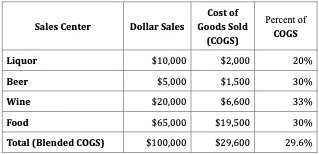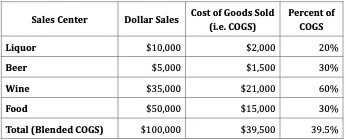
Every once in a while this crazy idea pops up: Why not sell wine in restaurants for retail prices? If, for instance, you can sell the same brands of premium Chardonnay or Cabernet Sauvignon for $5 to $7 a glass that other restaurants are selling for $15 to $20, why not? It’s a question worth exploring.
“Retail,” of course, can mean markups of anywhere from 20% to 50%—i.e., a bottle of wine costing $10 is sold for anywhere from $12 to $15, depending upon the type of store (from giant discount chains to smaller specialty markets). But generally speaking, most retail markups are somewhere in the neighborhood of 40%. That is, a bottle that costs $10 is marked up to $14 or $14.99. Hence, the typical retail formula for markups:
$10 x .4 = $4
$4 + $10 = $14/selling price
In the jargon of the restaurant industry, markups are defined in terms of COGS, or Cost Of Goods Sold. In this case, a bottle that costs $10 and sells for $14 would mean this wine is sold at 71.43% cost. To arrive at your restaurant markup on your calculator, you follow this formula:
$10 x 100 ÷ 71.43 = $14/selling price
However, as you know, the 71.43% cost typifying retail stores is far from the average markup in restaurants. The vast majority of restaurants mark wines up at least three-times, or roughly 33.33% cost. This means, a bottle that costs $10 typically sells for $30, minimum, in accordance with this formula:
$10 x 100 ÷ 33.33 = $30/selling price
In traditional restaurant food and beverage programs, anything approaching 50% to 70% retail style costing is considered crazy. The way the theory goes, in average fine dining restaurants, overall COGS (i.e., the cost of all goods sold, including foods and beverages) needs to add up to around 30%. Although everyone’s percentages vary, here is a realistic breakdown of goods for a restaurant doing $100,000 in overall sales, reflecting typical restaurant markups:
The reason a restaurant’s total Blended COGS cannot exceed 30% is because you must account for other major cost factors, such as labor. You can’t run a restaurant without cooks doing the cooking, servers doing the serving, hosts doing the hosting, etc.
If labor can also be kept to around 30%, you would end up with a total Prime Cost (i.e., your Blended COGS plus labor costs) of just under 60%. For virtually all restaurants, Prime Costs should never exceed 65% because you also need at least 35% to cover additional operating expenses, fixed costs (like occupancy), and of course, the goal of achieving profit and cash flow. That is to say: If you want your restaurant to eke out enough profit to just survive, you must control costs one way or another. Otherwise, you’re just spinning your wheels.
Which brings us back to our original question: Is it possible to sell wine at a cost more typical of retail style markups rather than what is typical in restaurants? Yes, but only if you are able to increase wine sales from about 20% of your overall sales (typical of most restaurants) to closer to 35%. If this is not possible, I’d suggest beating a hasty retreat.
If, however, you are able to increase wine sales by implementing lower markups, the following would be a revised $100,000 sales model, illustrating how such markups might possibly work:
With the lower, retail-style wine markup (60% cost) in this model, your Blended COGS goes up from just under 30% to 39.5%. Combined with normal 30% labor costs, the Prime Cost in this scenario would hover around 69.5%—nearly 5% more than the maximum 65% most restaurants dare to operate on. Furthermore, if your lower wine markup also succeeds in increasing overall restaurant sales by 20%, you would be looking at additional profit of $12,100 for each additional $20,000 you do in business.
Is it better to stay with a lower, more traditional 30% Blended COGS to maintain a healthy Prime Cost, or is it better to run a daring 39.5% COGS to gain extra sales you otherwise would not have generated without the lower wine markups?
Look at it this way: If you can offer guests a restaurant experience that averages, say, $50 covers, that is every bit as good or better than what is offered by other restaurants averaging over $100 covers, you can increase your sales by being your guests' go-to choice. In this case, you are not just being competitive, you are clobbering your competition practically to death (speaking from the experience of being on the winning side of this strategy). The trick, of course, is to also clobber your competition with quality—not just quality of your wines but also quality of your cuisine, your service and your setting, all the things that make a successful restaurant successful. Markups are just part of the formula.
My other other caveat, though, is that sheer quality of wines is never good enough. Other factors include how good you are at selecting wines on a sensory basis that heighten your guests' culinary experiences and capture your market, how good you are at merchandising and promoting your wines, and how good you are at staff training, maintaining discipline and focus in fulfillment of your wine program goals and your leadership skills in general. Many sommeliers are more than good enough. But many lack the talent and vision, or are too lazy or uncommitted to come close to it. Question is, what about you?







Randy, for what its' worth, we've been doing retail pricing + very similar to what you're suggesting, for a long time, since 1989 actually. It works! And works well. Folks that love wine, food and great service come as much for our wine list (s) as they do for the food and service experience. Same for our by the glass program going back all that time... by the glass, literally anything on the list by the glass... if we open something radically expensive (whatever that means in 2024) we hand sell in the moment what ever's left... by the glass or bottle may end up being a once in a life experience for some folks... regardless the dining room/bar turns into community and fun... inventory, profit, consistent margin, all integrate into GREAT success, every time and with every concept we've ever built. Bravo!